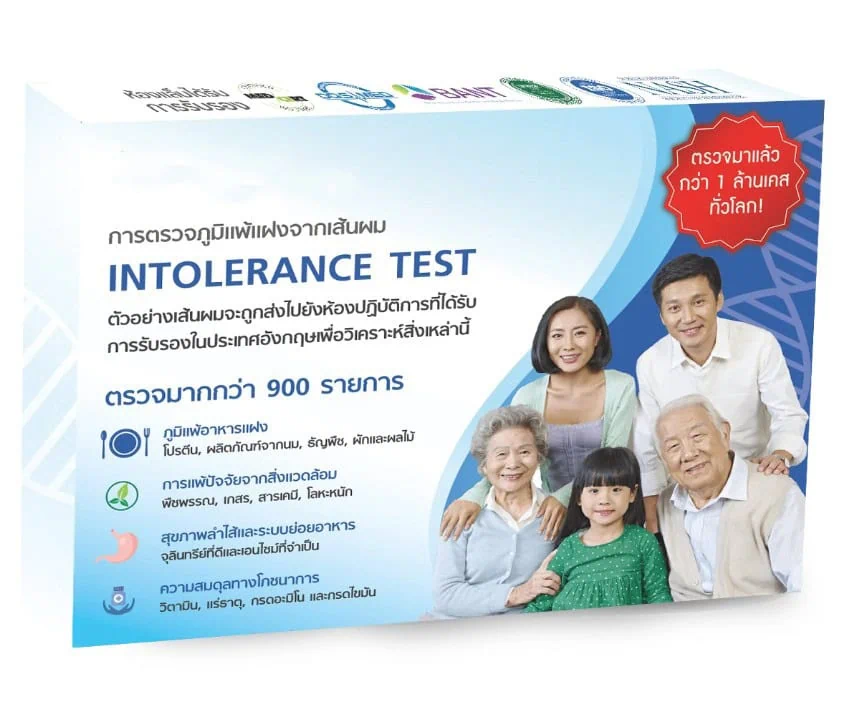Have you ever wondered if your headaches, bloating, itchy rashes, fatigue, or trouble sleeping could be caused by hidden allergies you didn’t even know you had? These symptoms may be your body’s way of trying to tell you something.
To help uncover potential allergens, we offer a new option: hair analysis for hidden allergies. Unlike traditional blood tests that require needles and can be painful, this method is completely non-invasive and painless. It’s suitable for both adults and children from 6 months old.
This test uses Bioresonance Technology from Europe, analyzing just a small hair sample to evaluate your body’s response to more than 900 types of food and environmental factors.
The results come in a clear and easy-to-understand report, showing which substances you should avoid and which are safe for consumption. This allows you to adjust your diet and lifestyle to better match your body’s needs.
Allergy vs. Intolerance — What’s the difference?
| Allergy | Intolerance |
|---|---|
| A genetic condition present from birth | Caused by factors such as diet, lifestyle, and the environment |
| Reactions are often severe and happen quickly, such as swelling, difficulty breathing, nausea, or even seizures | Reactions may not appear immediately, and can include indigestion, diarrhea, or itchy skin |
| Rooted in immune system dysfunction | Can be managed and lived with through lifestyle adjustments |
| Symptoms tend to last a lifetime | Often temporary and can change or disappear entirely |
What is hair intolerance testing?
This test uses a small amount of your hair as a sample. The hair is analyzed using Bioresonance Technology to screen for foods, additives, and environmental factors that may not be compatible with your body.
The results are presented in a clear report, showing different levels of sensitivity, so you can adjust your diet and lifestyle accordingly.
What can hair intolerance testing reveal?
1. Food Intolerances
Identifies sensitivities to foods such as dairy, eggs, meat, fish and seafood, vegetables, fruits, vegetarian options, nuts, beverages, herbs, and more.
2. Environmental Intolerances
Tests for reactions to trees, flowers, plants, grasses, insects, clothing materials, and organic environmental substances.
3. Heavy Metal Toxicity
Screens for sensitivities to heavy metals such as lead, zinc, rhodium, titanium, and others.
4. Vitamin and Mineral Imbalance
Checks for deficiencies or imbalances in essential vitamins (A–K), minerals, and phytonutrients crucial for overall health.
5. Intolerances to Additives
Includes artificial sweeteners, food colorings, antioxidants, preservatives, thickeners, and more.
6. Gut Health and Digestive System
Provides insight into how your digestive system responds to various factors, helping to guide lifestyle and dietary adjustments.

Who Can Benefit from This Screening Test?
This test can be especially helpful for people who’ve been dealing with ongoing health issues — whether it’s chronic digestive problems like bloating, heartburn, or irregular bowel movements. It’s also suitable for individuals struggling with skin conditions or nervous system issues, from persistent rashes and acne to migraines.
Another key group includes those experiencing sleep disturbances, unstable weight, or mood swings without a clear explanation. It’s particularly useful for anyone who has tried adjusting their diet on their own but hasn’t seen meaningful results and wants a clearer starting point.
However, this test is not recommended for people with a history of severe allergic reactions such as difficulty breathing, facial swelling, or anaphylactic shock. If you have any pre-existing medical conditions, it’s best to consult your doctor before proceeding.
Test Procedure & Preparation
Step 1: Initial Consultation
Start with a conversation with our team or a specialist about your symptoms and concerns. This helps us determine the most suitable testing focus for your situation.
Step 2: Hair Sample Collection
Accurate sample collection is crucial. Hair should be clean and dry, with no oils, sprays, or other products applied. A small section of hair, approximately 1–3 centimeters from the root, will be collected.
Step 3: Submit Sample & Receive Results
Once your sample is submitted, simply wait for the results. You’ll receive your report conveniently via email or Line.

What to Do After Receiving Your Results
- Start by focusing only on the key trigger items. Gradual adjustments will give your body time to adapt more smoothly.
- Keep a symptom journal — note what you eat, the time you eat it, and any symptoms you experience. Aim to track this for at least 4–6 weeks.
- Reintroduce or eliminate foods one item at a time to confirm what’s truly causing the reaction.
Health Check-Up Program
Benefits
- Painless, no fasting required, and suitable for both children and adults.
- Serves as a clear starting point to adjust your diet systematically, rather than guessing.
- Can be combined with guidance from doctors or nutritionists for long-term lifestyle improvements.
Important Notes & Cautions
- This is not a medical diagnosis for allergies and cannot confirm or rule out any disease.
- The accuracy of the test remains a topic of debate, so results should be interpreted together with real symptoms.
- Pregnant or breastfeeding individuals, as well as those with chronic illnesses, should consult a doctor before proceeding.
Reference:
1. Evidence-Based Versus Non Evidence-Based Tests and Treatments for Allergic Disorders
2. Fact or fiction: Hair test for food allergies
Contact Siam Clinic Phuket
- Map : https://g.page/SiamClinicPhuket
- WhatsApp : https://wa.me/66884486718
- Tel : 088-488-6718 และ 093-692-5999
- Email : [email protected]
- Facebook inbox : https://m.me/siamclinicthailand
- Instagram : https://www.instagram.com/siamclinic
- Line@ : https://lin.ee/uny1D7n

